A visit to Obana, a traditional Edo-mae unagi-ya (old Tokyo style eel restaurant)
Just because I am Japanese doesn't mean that I like all Japanese food. There are quite a few things I don't really hanker after, and unagi or freshwater eel is one of them. This is due to a very painful, literally gut-wrenching encounter with an unagi no kabayaki (grilled unagi with special sauce) that I had one summer in my mid-teens. Since then, I've only been able to tolerate unagi in very small doses, if at all. On the rare occasion when I've dived into a major portion of unagi, I've always come away regretting it. Too oily. Too earthy. Too...etc. etc.
Yet, on a sunny Saturday morning a couple of weeks ago, when my stepfather proposed that we go out to Minami Senjuu for some unagi feasting at Obana, I only hesitated for a minute. When it comes to fresh fish and traditional food in general, my stepfather and mother are the the most demanding people alive. If they both agree that a restaurant is good enough to sacrifice a lazy weekend afternoon's worth of lounging around on the sofa for, then it really is good.
So off we went. To get to Obana, the closest station is Minami Senjuu (南千住; see below for details). Once you get out of the station and veer to your left, past the store that sells various traditional Japanese snacks (I don't recommend that store by the way...very mediocre wares), you'll find yourself on a small side street that runs right next to the train tracks. Almost every electric wire pole on the street points you to Obana.

Once you get to the Obana entrance around lunchtime or so, it's impossible to miss, since you will most likely encounter a line of hungry people waiting to get in. Your nose will also tell you where the unagi is. The traditional 'in' season for unagi is during the dog days of summer, and in July the line can stretch all the way out down the road, but since we went in November it only reached the entrance to the front garden.
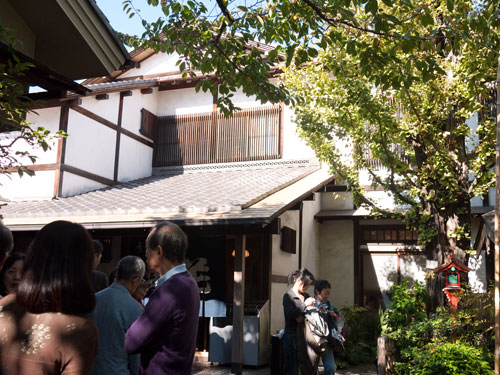
While we waited, a friendly yet no-nonsense lady came out to take our unagi orders. Obana only starts processing the unagi after it's ordered. She told us that it it would be about a 30 minute wait. We amused ourselves by staring at the little garden and tiny oinari-san or Shinto shrine. (People paying attention to this site may notice that oinari-san is also an alternate way of calling inari zushi, but I digress.)
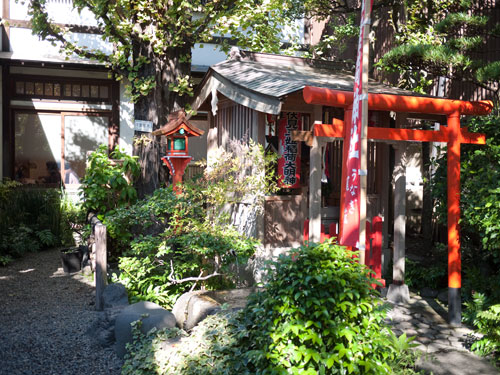
After the promised 30 minutes, give or take a few minutes, we were finally seated inside. Now, one caveat about Obana is that there is no Western style table and chair seating. All guests sit on the tatami mat floor. This may be quite uncomfortable for you, so be aware of this. For most Japanese people this is not a problem of course. (I won't talk about my own posture after half an hour of trying to sit properly. Let's just say, I was sure glad I wasn't wearing a skirt.)
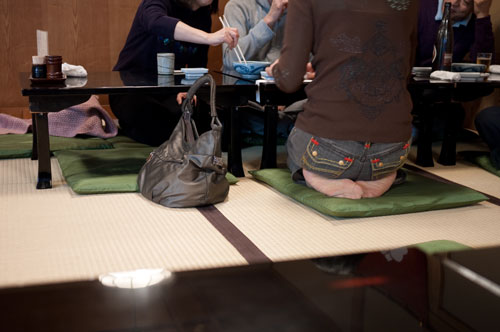
Although unagi orders are placed in advance, appetizer orders are taken after you're seated. They arrive before the main unagi. First some oshinkou or homemade pickled vegetables. I am very picky about my oshinkou and these were excellent, not too salty, fresh tasting but still packed with natural umami.

Next some umaki, tamagoyaki (or rather, the refined cousin of tamagoyaki, dashimaki tamago, which is made with a mixture of dashi stock and beaten egg) stuffed with unagi. The even yellow! The thin, even, moist layers! The oily, just slightly sweet unagi filling! Delicious does not even begin to describe it.

I was not as enthusiastic about the kimosui, clear soup with unagi guts. It tasted like, well, guts. I am not that fond of guts in general, even though that confession may disqualify me as a true gourmet or something.
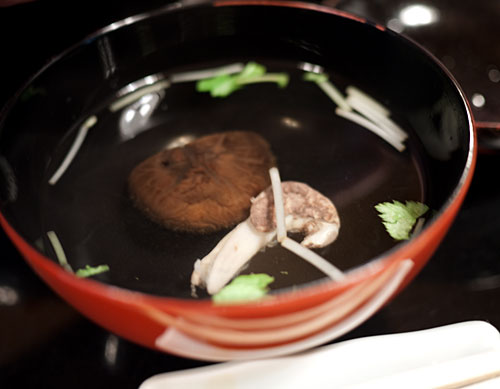
Then, the best appetizer of all, shirayaki, or plain grilled unagi. It was so fresh and delicate and tender, with none of the slightly unpleasant earthiness that you get with unagi at so many places.
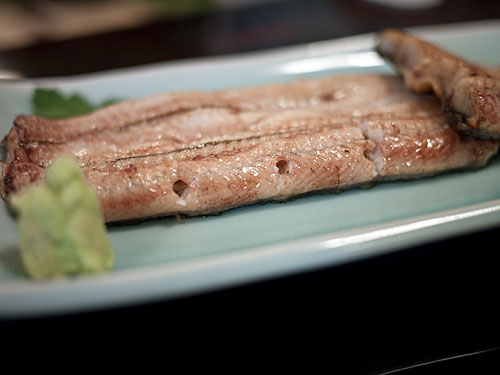
(Note, it takes some time for the unagi main course to arrive. So it's best to linger over the appetizers. You can also order a lot of drinks if you want as you wait, though we didn't.)
The star of the show of course, is the unajuu - grilled unagi with shiny, mouthwatering sauce, nestled on on a bed of rice. Obana has three differently priced unajuu on their menu (4,000 yen, 3,500 yen and 3,000 yen at the time of this writing); basically the price differs according to the thickness and size of the unagi. My stepfather had the most expensive one, I had the mid-sized, and my mother had the small one. The small and large ones came in square lacquer boxes.
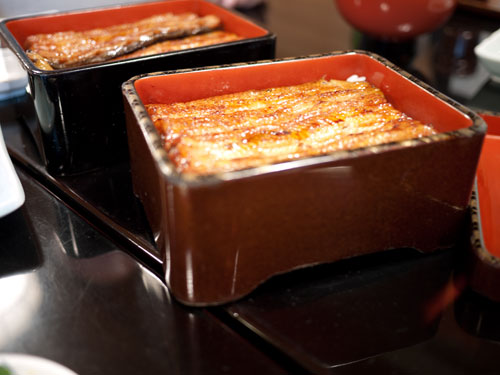
My midsize one came in a bowl. 'Melts in your mouth' is such a food cliché, but really, this unagi melted in the mouth. It was so very rich yet refined at the same time. My mother normally has a lot of trouble with oily fish, but she gobbled her unagi up while making little happy noises. The rice (most likely shinmai or new harvest rice) tasted great too.

Full of unagi goodness, we managed to hoist ourselves up from the floor (well, I hoisted myself up, somehow...hey, I'm not used to the tatami lifestyle anymore) and waddled out happily. I snuck a shot of the open kitchen as we left. It looked impeccably clean, which is always reassuring to see in a restaurant. Those stacked up wooden containers are the steamers in which the unagi are cooked before grilling.
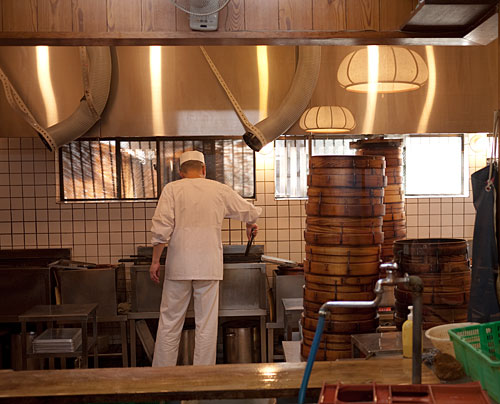
Here's a very happy customer, emerging back out into the sunshine.
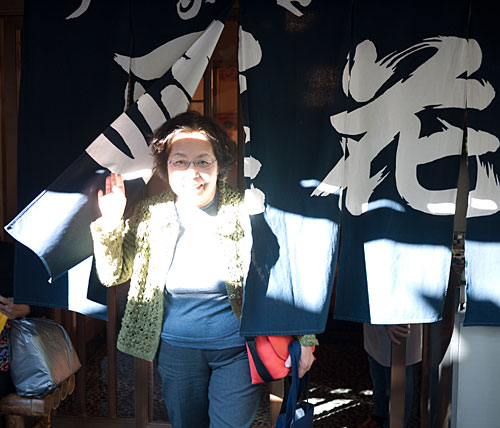
Obana is old and famous
Established in the early 19th century, Obana is not an unknown commodity by any means. It's rated tops in the unagi-ya category on the Japanese restaurant-rating sites like Tabelog and Gurunabi, and has been written up frequently enough in the English media that people even snark about it, complaining that it's too expensive, it's too out of the way, the unagi is too soft, whatever. All I can say is, nuts to those people. Obana is a great place to experience the best true Edo-mae (old Tokyo style) unagi in a very traditional Japanese setting.
Practical details
Obana (尾花)is near the Minami Senjuu (南千住)station on the JR Joban Line (常磐線)or the Tokyo Metro Hibiya Line (東京メトロ日比谷線). There's nothing else to see or do at Minami Senjuu, so you will have to decide for yourself if an unagi feast is worth the detour for you. Note also that Obana's prices are higher than your run of the mill unagi-ya's.
Obana opens at 11:30 and keeps serving all afternoon until they run out of unagi in the summer. If you don't want to wait a long time, try to line up around 11 or even earlier in the summer. During other times of the year they close for a couple of hours in the afternoon. In any case, once they're out of unagi they're done. Obana does not take reservations. If you're meeting people there, your whole party has to be assembled before they let you in. Once you're inside and seated, it still takes a good hour for your unajuu to arrive, since as I mentioned they only start preparing the unagi after taking the order. Don't schedule a visit here before you have to be someplace.
As far as I could tell they did not have an English menu, but hey there are just so many things you can order there. (I would recommend all the appetizers I've described above, plus the uzaku (raw unagi with cucumber). They have other things too like yakitori, if you must go with a non-unagi eater, though as a usually-non-unagi-eater I'd urge them to give Obana a try.)
Address in Japanese:
東京都荒川区南千住5-33-1
Tel: 03-3801-4670
Hours of operation:
M-F: 11:30〜13:30、16:00〜19:30
Sat/Sun: 11:30〜19:30
Closed Mondays. Also takes some holidays during the year.
No reservations taken
NOTE: I am not your concierge or travel agent, so please, if you want to make specific inquiries to them, have your hotel concierge or Japanese speaking friend do this for you.
A bit of unagi trivia
In Tokyo, unagi is prepared by slitting the eel down the back, while in Kyoto it's slit down the front or belly. This is because Tokyo (formerly Edo) was a samurai warrior town, and slitting the belly of something (seppuku!), even a humble eel, was considered to be bad luck.
If you enjoyed this article, please consider becoming my patron via Patreon. ^_^

 Welcome to Just Hungry, where we serve authentic Japanese recipes and more! I'm
Welcome to Just Hungry, where we serve authentic Japanese recipes and more! I'm 












Comments
Thomas
17 November, 2010 - 16:28
Permalink
Re: A visit to Obana, a traditional Edo-mae unagi-ya (old ...
Another thoughtful and inspired piece of writing profusely illustrated with mouth-watering photos. I haven't given much time to unagi but may have to now!
wintersweet
17 November, 2010 - 19:22
Permalink
Re: A visit to Obana, a traditional Edo-mae unagi-ya (old ...
That sounds great! I'm not really an unagi fan, but my husband loves it. If we ever get back to Japan, this place will be on our list. (The umaki is really intriguing!)
--
http://www.readableblog.com (for English learners)
http://www.talktotheclouds.com (for teachers)
sairth
18 November, 2010 - 00:21
Permalink
Re: A visit to Obana, a traditional Edo-mae unagi-ya (old ...
Looks amazing!
huda
18 November, 2010 - 04:29
Permalink
Re: A visit to Obana, a traditional Edo-mae unagi-ya (old ...
I love unagi on rice..Great post! Japan is full of old but interesting places!! I have to go to Japan one day and visit Obana ^__^
kitty-chan
18 November, 2010 - 06:23
Permalink
Re: A visit to Obana, a traditional Edo-mae unagi-ya (old ...
Unagi is hands down my favorite fish. I only wish it were easier to find in the DC area...
I wish I had known about this place over the summer! I had been looking for a place to get some nice eel on "Eel Day" (Doyo Ushi no Hi) and ended up at a smoky, sub-par place in Shibuya.
Someday when I return I'll definitely check it out. Its an area of the city I hadn't been to, and a little food adventure is definitely worth the trip.
Max Pinton
18 November, 2010 - 08:23
Permalink
Re: A visit to Obana, a traditional Edo-mae unagi-ya (old ...
Interesting as always. I'm pretty squeamish on eel, but this all looks really tasty.
I noticed that お新香 is both oshinko and oshinkou. I order oshinkomaki a lot and I've never seen the long-o form -- is it something different or just an optional u?
maki
18 November, 2010 - 08:54
Permalink
Re: A visit to Obana, a traditional Edo-mae unagi-ya (old ...
Properly read 香 is pronounced kou with a long 'oh' sound, but it often gets shortened to 'ko'.
jerry
18 November, 2010 - 12:13
Permalink
Re: A visit to Obana, a traditional Edo-mae unagi-ya (old ...
my wife and myself have been a huge Japanese culture fan, especially the food :D
love your food blog.
keep them coming.
miwa
18 November, 2010 - 19:10
Permalink
Re: A visit to Obana, a traditional Edo-mae unagi-ya (old ...
The restaurant you mentioned looks steeped in tradition and may very well be thoughtful about the origin of their eel catch. Indeed it looks fabulous! I just feel the need to point out to at least your U.S. readers that Unagi is not a very sustainable choice.
Even though they are "farmed" they are not bred in captivity. Rather the young are taken from the wild. I've heard that a lot of the eel's reproductive practices are a mystery to biologists. (not confirmed). Here is the monterey bay seafood watch assessment of eel:
http://www.montereybayaquarium.org/cr/SeafoodWatch/web/sfw_factsheet.asp...
It's convenient that I (nor any of my japanese family) like unagi very much. Although I seem to notice it's a bit of a "gateway drug" to the sushi world for people who don't like the idea of sushi at first.
orangefleabait
18 November, 2010 - 21:04
Permalink
Re: A visit to Obana, a traditional Edo-mae unagi-ya (old ...
i love unagi!! what a great tradition to celebrate with your parents.
i love your blog! this is my first comment, about an issue i feel must be addressed.
PLEASE, there are so many people that read your blog, you are in a position to make a difference in a lot of peoples lives. all over the world we have more choices than ever about what we eat. over fishing is a major problem and unagi is NOT an evolved eating choice. they are over fished, even when farmed, and habitat loss is a serious issue as well.
monteray bay aquarium has a very thoughtfully presented list of fish populations all over the world, including not only information about over fishing practices species by species, but also fish that have been found to contain especially high levels of mercury or pcbs. this is for everyone's benefit! please give it some thought, you seem like a very articulate and conscious food lover!
http://www.montereybayaquarium.org/cr/SeafoodWatch/web/sfw_factsheet.asp...
cheers and good eating!
maki
18 November, 2010 - 21:08
Permalink
Re: A visit to Obana, a traditional Edo-mae unagi-ya (old ...
Thanks for making your point about the sustainability of unagi. I do not think that unagi is something that should be eaten in large, everyday quantities. It's an occasional indulgence. Hopefully the habitat and fishing issues can be resolved soon.
Now if there is some site or something encouraging people to leave very similar comments about this issue here, all further such comments will be deleted. This is not a forum for your political agenda, whatever it might be. Thanks for your understanding.
Shari
19 November, 2010 - 07:52
Permalink
Re: A visit to Obana, a traditional Edo-mae unagi-ya (old ...
I love, love, love unagi. Just reading this post is making me hungry, despite the ridiculous hour. I'm definitely going to have to add this to my list of places to go to. If it's as good as you say, I'd be happy to make an afternoon out of it.
As for the eel population... NatGeo just had an article on eels. Turns out there may be a breakthrough with farming them (from scratch.) Hope this turns out to be true, as I love me my unagi! :)
anon.Ayse
19 November, 2010 - 08:45
Permalink
Re: A visit to Obana, a traditional Edo-mae unagi-ya (old ...
I love getting your email and pics ..I read them all ,...its never boring and I do use your recipes ..Thank you very much from White Rock, BC
Marie
21 November, 2010 - 01:06
Permalink
Re: A visit to Obana, a traditional Edo-mae unagi-ya (old ...
I love unagi, but I haven't had the high quality stuff in recent memory. Lovely pictures and post!
anon.
21 November, 2010 - 15:11
Permalink
Re: A visit to Obana, a traditional Edo-mae unagi-ya (old ...
I bookmarked this place! I'm persuading my group to go there when we go visit Japan end of the year! Could you tell me if the place will be open on the 30th of December? Also, do we need to be able to speak Japanese to order food? Thanks!
maki
21 November, 2010 - 15:40
Permalink
Re: A visit to Obana, a traditional Edo-mae unagi-ya (old ...
Your best bet is to have your hotel concierge (or a Japanese speaking friend) call them and ask for you, once you are in Tokyo.
anton
26 November, 2010 - 04:19
Permalink
Re: A visit to Obana, a traditional Edo-mae unagi-ya (old ...
The popular youtube channel cookingwithdog had a pretty good recipe video for ひつまぶし (hitsumabushi) recently.
http://www.youtube.com/watch?v=p4KFCAX6X4o
This came in quite handy.. I recently bought a frozen unagi and wasn't sure how to prepare/serve it.
maki
26 November, 2010 - 05:53
Permalink
Re: A visit to Obana, a traditional Edo-mae unagi-ya (old ...
Call me prejudiced, but to me frozen unagi is one of those Not Worth Buying items. ^_^; (I'd rather stick with a cheaper tastier fish instead.)
Ben
29 November, 2010 - 00:26
Permalink
Re: A visit to Obana, a traditional Edo-mae unagi-ya (old ...
OMG... That all looks soooo delicious!
niamh
29 November, 2010 - 10:09
Permalink
Re: A visit to Obana, a traditional Edo-mae unagi-ya (old ...
Wow, this looks great.
I love unagi and I live nearby....I think I need to visit Obana!!!
http://itsonlysight.blogspot.com/
Jane
4 January, 2011 - 05:01
Permalink
Re: A visit to Obana, a traditional Edo-mae unagi-ya (old ...
Currently, I'm really wishing for Doreamon to be here... I want to borrow his dokodemo doa and go to this unagiya, as well as the tampopo restaurant you mention, and some other places....
looking at the pictures makes me hungry again....
Jessica
21 July, 2012 - 03:22
Permalink
Re: A visit to Obana, a traditional Edo-mae unagi-ya (old ...
were the appetizers you mentioned included in the price or were those extras? I'm thinking of taking my brothers here when they visit but our budget is a bit tight.
maki
21 July, 2012 - 10:36
Permalink
Re: A visit to Obana, a traditional Edo-mae unagi-ya (old ...
The appetizers are extra. Obana is not cheap, but it's really good.